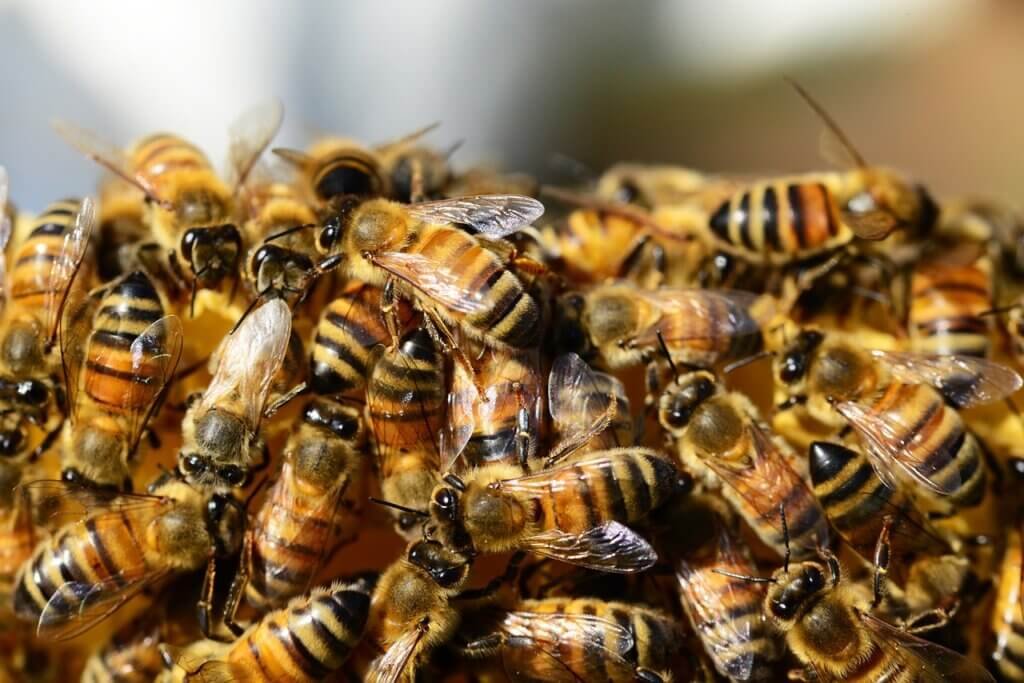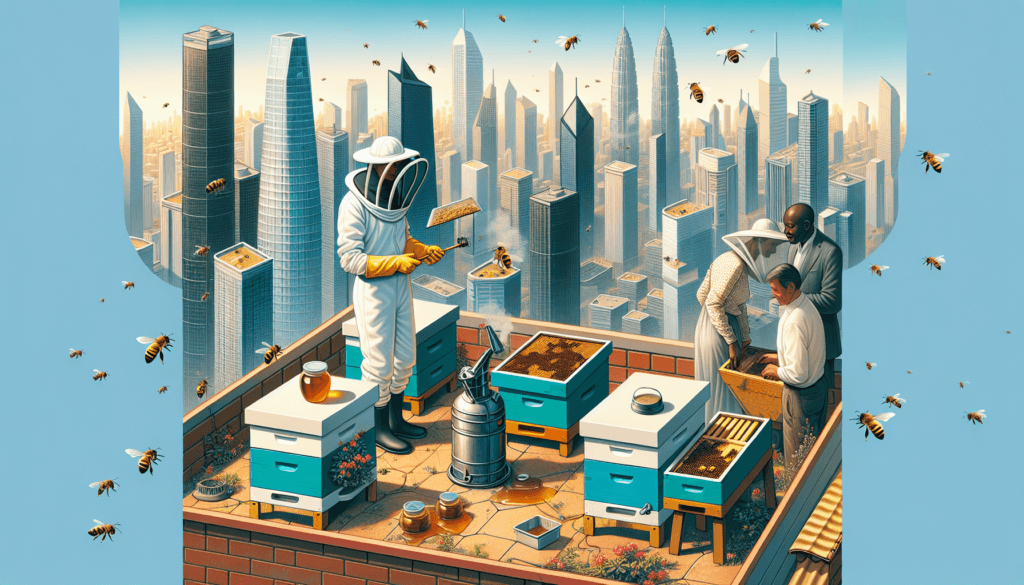Imagine stepping into your own backyard, surrounded by the buzz of bees working diligently to pollinate your garden. This is the reality for many urban beekeepers, as the practice of beekeeping continues to rise in popularity. In this article, we will explore the increasing interest in urban beekeeping and provide you with the essential information needed to start your very own hive. From the benefits to the challenges, we will guide you through the process of becoming a successful urban beekeeper, fostering a harmonious relationship with these incredible pollinators. So grab your beekeeping suit and get ready to embark on this rewarding and environmentally-friendly venture!

Understanding Urban Beekeeping
Benefits of urban beekeeping
Urban beekeeping offers numerous benefits to both bees and the local community. By providing a safe and suitable habitat for bees, urban beekeepers contribute to the preservation and conservation of these crucial pollinators. Bees play a vital role in the pollination of flowers, fruits, and vegetables, supporting overall biodiversity and food production.
In addition to the environmental benefits, urban beekeeping also brings economic advantages. The presence of bees in urban areas can enhance crop yields, leading to increased agricultural productivity. Honey production and the sale of hive products can also provide a source of income for beekeepers.
Challenges of urban beekeeping
While urban beekeeping offers numerous advantages, it is not without its challenges. One major concern is the limited foraging resources available to bees in urban environments. In cities, green spaces may be limited, and pesticide use can pose a threat to bee health. Beekeepers must carefully manage their hives, ensuring adequate food sources and minimizing the exposure of bees to harmful substances.
Another challenge is the potential for conflicts with neighbors or local regulations. Some individuals may be afraid of bees or misinformed about their behavior, leading to concerns or complaints. It is crucial for urban beekeepers to maintain open lines of communication with their neighbors and address any concerns promptly and respectfully.
Legality of urban beekeeping
Before starting an urban beekeeping venture, it is essential to research and understand the local laws and regulations regarding beekeeping. Some cities have specific ordinances and requirements related to hive placement, hive density, and registration. Municipalities may also have guidelines for notifying neighbors or obtaining permits.
By familiarizing yourself with the legal requirements, you can ensure that your urban beekeeping activities are compliant and promote positive relationships within your community.
Choosing the Right Location
Considerations for selecting a location
Choosing the right location for your beehive is crucial to the success of your urban beekeeping endeavor. Some key considerations include the availability of forage, the accessibility of water sources, and the proximity to potential hazards.
Ideally, you should select a location with a variety of flowering plants that can provide a consistent and diverse source of pollen and nectar for your bees. Avoid areas with heavy pesticide use or pollution, as these can negatively affect bee health.
Creating a bee-friendly environment
To attract bees to your urban beekeeping site, it is essential to create a bee-friendly environment. Planting a diverse range of flowering plants and herbs in your garden or on your rooftop can provide abundant forage for bees throughout the year. Choose plants that bloom at different times to ensure a continuous food supply.
In addition to planting bee-friendly flora, consider incorporating water sources such as shallow birdbaths or small fountains. Bees require water to maintain hydration and regulate hive temperature. Ensuring a nearby water source will encourage bees to visit your hive and reduce the likelihood of them seeking water from less desirable locations, such as swimming pools or bird feeders.
Urban hazards to be aware of
Urban environments can present unique hazards to bees. Pesticides commonly used in landscaping or on public spaces can be toxic to bees, so it is crucial to be aware of any pesticide applications in your area. Be mindful of the potential for exposure and take steps to mitigate risks, such as communicating with local authorities or nearby businesses about your beehive’s presence.
Additionally, be mindful of air pollution and other environmental factors that may impact bee health. Certain plants commonly found in cities, such as some species of lilies or ornamental flowers, can be toxic to bees. Familiarize yourself with local flora and avoid planting potentially harmful species near your hive.

Building or Buying a Hive
Different types of beehives
When it comes to beehive selection, there are several options available to urban beekeepers. The most common types of hives include Langstroth hives, top-bar hives, and Warre hives.
Langstroth hives are the most widely used and consist of vertically-stacked frames that allow for easy inspection and management. Top-bar hives use horizontal bars instead of frames, making them a more accessible option for beginners and those who prefer a more natural approach to beekeeping. Warre hives are similar to Langstroth hives but follow a different management philosophy, promoting minimal intervention and allowing bees to construct their own comb.
Factors to consider when choosing a hive
When choosing a hive, several factors should be taken into account, including personal preference, available space, and local regulations. Consider the amount of time and effort you are willing to invest in hive management, as some hive types may require more hands-on attention than others.
It is also important to assess the climate in your area as different hive designs may be better suited to specific climates. For instance, in regions with cold winters, hives that provide good insulation may be preferable to protect bees from harsh weather conditions.
Setting up the hive
Once you have selected a hive, it is time to set it up in your chosen location. Make sure the hive is level and stable, as any instability can disrupt the bees’ comb-building process. Position the hive entrance to face a safe and accessible direction, away from high human traffic areas.
Take into consideration the airflow around the hive to ensure proper ventilation. Adequate ventilation helps regulate the temperature inside the hive and prevents excessive moisture buildup, reducing the risk of diseases.
Obtaining Bees
Purchasing a bee package or nucleus colony
To start your hive, you will need to obtain bees. One option is to purchase a bee package or a nucleus colony. A bee package consists of a pre-determined number of bees and a queen, usually enclosed in a screened box. A nucleus colony, or “nuc,” is a small working hive with a queen, brood, and bees on several frames.
When purchasing bees, it is important to source them from reputable suppliers who prioritize the health and well-being of their bees. Local beekeeping associations and online forums can provide valuable recommendations for trusted sources.
Catching a swarm
Another way to obtain bees is by catching a swarm. Swarms occur when a colony divides and a portion of bees leaves the hive in search of a new home. If you come across a swarm in a safe and accessible location, you may be able to capture it and relocate it to your hive. However, it is crucial to have the necessary knowledge and experience to handle swarms safely.
Contacting local beekeeping associations
Local beekeeping associations can be an excellent resource for finding bees. These organizations often have established networks of beekeepers who may have surplus bees available for purchase or be willing to mentor new beekeepers. By connecting with the local beekeeping community, you can gain invaluable support and advice throughout your beekeeping journey.

Preparing for the Arrival of Bees
Preparing the hive
Before the arrival of your bees, it is essential to prepare the hive. Ensure that all hive components are in place and properly assembled. Clean the hive thoroughly to remove any debris or potential contaminants. Bees prefer a clean and tidy environment, so taking the time to prepare the hive will help them feel comfortable and settled.
Place frames with foundation or starter strips inside the hive to provide bees with a guide for building their comb. Check that the frames fit snugly and leave enough space for the bees to move between them.
Setting up water sources
Bees require access to a reliable water source for drinking and cooling the hive. Without a nearby water source, bees may venture far from your hive in search of water, potentially leading to conflicts with neighbors or other undesirable locations.
Create a water source near your hive by placing a shallow container filled with water. Add a few stones or twigs to provide bees with a safe landing spot and prevent accidental drowning. Regularly monitor and refill the water container to ensure a continuous supply.
Gathering necessary equipment
To properly care for your bees, it is important to gather the necessary equipment. Basic beekeeping tools include a bee suit or veil to protect yourself from stings, gloves, a smoker, and hive tools.
A bee suit or veil is essential for your safety and comfort while working with bees. It provides protection from stings and can help alleviate anxieties or concerns about being in close proximity to bees.
A smoker is a device used to calm bees by emitting cool smoke. This smoke triggers a defensive response in bees, causing them to consume honey and prepare for potential relocation rather than attacking. Hive tools, such as a hive tool or bee brush, are used to pry apart hive components and gently remove bees when necessary.
Beekeeping Equipment and Tools
Essential beekeeping clothing
Proper beekeeping clothing is crucial for your safety and comfort when working with bees. A bee suit or jacket made from a lightweight, breathable material provides full-body protection against bee stings. It should include a veil that covers your face and neck to prevent bees from coming into contact with your skin.
Choose clothing that fits well and allows for freedom of movement. Avoid dark-colored clothing, as bees are more attracted to dark colors. Light-colored suits or jackets are preferable, as they can help deter bees from approaching too closely.
Smokers and hive tools
Smokers and hive tools are essential for managing beehives effectively. A smoker is used to emit cool smoke into the hive, helping to calm the bees and make hive inspections easier. It is important to use a smoker correctly to avoid causing unnecessary stress to the bees or harming their health.
Hive tools, such as a hive tool or bee brush, are used to pry apart hive components, scrape off excess wax or propolis, and gently remove bees when needed. These tools aid in maintaining the hive and performing routine inspections without causing excessive disturbance to the bees.
Supplementary equipment
In addition to the beekeeping essentials, several supplementary pieces of equipment can enhance your beekeeping experience. Honey extractors, for example, allow you to harvest honey efficiently. This equipment spins the honeycomb frames, separating the honey from the wax.
Other helpful tools include pollen traps, which collect pollen for bee pollen harvesting, and queen excluders, which prevent the queen from laying eggs in certain sections of the hive. While not required for basic beekeeping, these tools can add value to your urban beekeeping venture.

Caring for Your Bees
Feeding your bees
While bees primarily obtain their nutrition from foraging, there may be times when supplemental feeding is necessary. This is especially true during periods of sparse nectar flow or in the early stages of hive establishment.
Beekeepers can provide sugar syrup, made with a mixture of granulated sugar and water, to supplement bees’ food supply. Pollen substitutes or pollen patties can also be provided to ensure a balanced diet. However, it is important to remember that natural forage is generally the best source of nutrition for bees.
Monitoring hive health
Regular monitoring of hive health is crucial for identifying potential issues and taking early action. Conduct routine inspections to check for signs of disease, pests, or inadequate food stores. Look for any abnormalities, such as dead bees, unusual discoloration, or foul odors, which can indicate potential problems.
Monitoring the brood pattern, the presence of the queen, and the overall population is also essential. Document your observations to track hive progress over time and identify any patterns or trends that may require further attention.
Dealing with pests and diseases
Pests and diseases pose significant risks to bee colonies and can impact hive health and productivity. Common pests include varroa mites, wax moths, small hive beetles, and ants. Diseases such as American foulbrood and European foulbrood can also threaten hive survival.
To protect your bees, it is important to implement appropriate pest management strategies, such as mite treatments and regular hive inspections. Some methods include the use of organic treatments, essential oils, or physical traps. If you suspect the presence of a disease, consult with a local beekeeping expert or extension office for guidance on diagnostics and treatment options.
Harvesting Honey and Other Hive Products
Knowing when to harvest
Harvesting honey at the right time ensures optimal flavor and quality. Bees need to store enough honey to sustain themselves throughout the winter, so it is important not to harvest too early and risk depriving them of their food supply.
Wait until the bees have capped most of the honey cells, indicating that the honey is sufficiently ripe. Look for uniformly capped cells and a moisture content of around 18-20%. Monitoring the hive’s weight and assessing the amount of honey stored can also provide valuable indicators of readiness for harvest.
Extracting honey
Extracting honey from the frames involves removing the capped cells and separating the honey from the wax. The most common method is to use a honey extractor, which uses centrifugal force to extract honey without damaging the comb.
Before extraction, ensure all equipment is clean and sanitized to maintain the quality and purity of the honey. Uncap the cells using a hot knife or uncapping fork, then place the frames in the extractor. Spin the extractor, and gravity will cause the honey to flow out, ready for collection.
Collecting other hive products
In addition to honey, beehives produce various other valuable products that can be collected and utilized. Beeswax, for example, can be harvested by melting and straining the cappings removed during honey extraction. Beeswax has numerous uses, including candle making, cosmetics, and beeswax wraps.
Bee pollen, collected from the pollen traps added to the hive entrance, can be harvested and consumed as a nutrient-rich food supplement. Propolis, a resinous material bees use to seal gaps in the hive, has antimicrobial properties and can be collected and used for medicinal or cosmetic purposes.

Urban Beekeeping Best Practices
Beekeeping as a responsible neighbor
As an urban beekeeper, it is important to be a responsible and considerate neighbor. Communicate with your neighbors about your beekeeping activities, address any concerns they may have, and provide education on the benefits of bees and beekeeping.
Ensure that your hive’s flight path does not interfere with public areas or neighboring properties. Position your hive in a location that minimizes bee traffic near people or areas where bees may cause a disturbance. Good hive management practices, such as regular inspections and control of swarming, can help prevent conflicts and ensure a harmonious coexistence with your neighbors.
Ensuring safety and health
Safety should always be a priority when practicing urban beekeeping. Regularly inspect your hive for any signs of aggression or abnormal behavior, and take appropriate action if necessary. Ensure that your beekeeping clothing is in good condition and properly worn during hive inspections.
Maintain a clean and hygienic hive environment to minimize the risk of pests and diseases. Keep the area around the hive free of debris or standing water, which may attract unwanted pests. Regularly monitor and address issues such as inadequate food stores or overcrowding to ensure the overall health and well-being of your colony.
Educating the community
One of the most important aspects of urban beekeeping is community education and engagement. Take the opportunity to share your knowledge and passion for bees with your local community. Organize educational workshops or open hive days to provide insights into the world of beekeeping and the essential role bees play in our ecosystems.
Collaborate with local schools or community organizations to arrange educational programs or hive visits. By spreading awareness and knowledge about bees, you contribute to fostering a sense of environmental stewardship and building a more bee-friendly and ecologically conscious community.
Connecting with the Urban Beekeeping Community
Joining local beekeeping groups
Connecting with local beekeeping groups is a valuable way to enhance your urban beekeeping experience. These groups provide a supportive network for sharing knowledge, exchanging ideas, and troubleshooting common challenges. By joining, you gain access to a wealth of expertise and guidance from experienced beekeepers.
Local beekeeping associations often organize regular meetings, workshops, and educational events. Attending these gatherings allows for networking opportunities and fosters connections with like-minded individuals who share your passion for bees.
Attending beekeeping conferences and workshops
Beekeeping conferences and workshops offer a chance to expand your knowledge and stay updated on the latest practices and research in the field. These events often feature expert speakers, demonstrations, and vendor exhibitions, providing valuable learning opportunities and access to new beekeeping equipment or products.
Attending conferences and workshops also allows you to connect with industry leaders, researchers, and fellow beekeepers from different regions. The exchange of experiences and perspectives can inspire innovative approaches and improve your overall beekeeping practices.
Sharing experiences and knowledge
Finally, one of the best ways to connect with the urban beekeeping community is by sharing your own experiences and knowledge. Write about your experiences in beekeeping journals or start a blog to document your journey. Social media platforms provide an excellent opportunity to share photos, insights, and helpful tips with fellow beekeepers and enthusiasts.
Contributing to online forums or beekeeping-related groups can also foster connections and facilitate the exchange of information. Engaging in conversations and offering support to other beekeepers helps create a sense of community and contributes to the collective knowledge of urban beekeeping.


